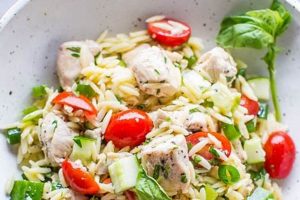This classic American dish features cooked chicken, often poached or roasted, combined with mayonnaise, celery, and onion. Variations may include grapes, nuts, herbs, or dried fruits. It’s typically served cold, often on bread, crackers, or lettuce cups.
A well-executed version offers a balance of creamy, savory, and subtly sweet flavors. Its versatility makes it suitable for a quick lunch, a picnic staple, or a component of a larger meal. Numerous interpretations exist, reflecting regional preferences and individual tastes. The enduring popularity of this dish speaks to its simplicity and adaptability.
The following sections will explore the preparation methods, ingredient selection, and serving suggestions for a successful and satisfying experience with this culinary staple.
Tips for a Superior Chicken Salad
Elevating this simple dish to culinary excellence involves attention to detail and thoughtful ingredient selection. The following tips offer guidance for achieving optimal flavor and texture.
Tip 1: High-Quality Chicken is Key: Using freshly roasted or poached chicken significantly enhances the overall flavor compared to pre-cooked or canned options. Bone-in, skin-on chicken contributes richness and moisture.
Tip 2: Proper Chicken Preparation: Allowing the cooked chicken to cool completely before shredding or dicing prevents a mushy texture. Consistent sizing of the chicken pieces ensures even distribution of flavor and a pleasant mouthfeel.
Tip 3: Fresh Ingredients Matter: Crisp celery and finely diced onion provide essential textural contrast and aromatic complexity. Using fresh herbs, rather than dried, elevates the overall freshness.
Tip 4: Mayonnaise Selection: The quality of the mayonnaise significantly impacts the final product. A full-fat mayonnaise offers superior richness and flavor. Consider adding a touch of Dijon mustard or lemon juice for a tangy counterpoint.
Tip 5: Seasoning with Care: Salt and freshly ground black pepper are essential seasonings. Start with a small amount and adjust to taste, avoiding over-seasoning. A pinch of celery salt can enhance the celery notes.
Tip 6: Balancing Flavors: Incorporating complementary ingredients like grapes, dried cranberries, or toasted nuts adds depth and complexity. A small amount of sweetness can balance the savory elements.
Tip 7: Chilling for Optimal Flavor: Allowing the chicken salad to chill for at least 30 minutes in the refrigerator allows the flavors to meld and deepen before serving.
By following these guidelines, one can transform a simple chicken salad into a truly memorable culinary experience.
These tips provide a foundation for creating a delicious and satisfying dish. Experimentation with variations and personal preferences is encouraged.
1. High-Quality Chicken
High-quality chicken plays a pivotal role in a successful rendition. The chicken provides the foundational flavor and texture, significantly impacting the overall dish’s quality. Tender, flavorful chicken elevates the salad, while dry, bland chicken can render it unappetizing. The choice of chicken directly influences the final result. Using freshly roasted or poached chicken, preferably from a reputable source, yields superior results compared to pre-cooked or canned options. The enhanced flavor and moist texture contribute significantly to a more satisfying culinary experience. For example, using a free-range, organic chicken can impart a subtle richness not found in conventionally raised poultry.
The impact extends beyond flavor. The texture of the chicken contributes significantly to the enjoyment of the salad. Dry, stringy chicken can create an unpleasant mouthfeel, whereas moist, tender chicken offers a more desirable texture. Proper cooking techniques, such as poaching or roasting, help retain moisture and ensure optimal tenderness. Overcooking should be avoided as it leads to dryness. Consider brining the chicken before cooking to further enhance moisture retention. This attention to detail elevates the final dish, demonstrating a commitment to quality.
Selecting high-quality chicken demonstrates a commitment to culinary excellence. This seemingly simple choice has profound implications for the final product. The enhanced flavor and texture contribute to a more satisfying and enjoyable experience. While cost considerations may tempt one toward less expensive options, the difference in the final product justifies the investment in superior ingredients. This principle underscores the importance of prioritizing quality ingredients for optimal culinary outcomes.
2. Flavorful Mayonnaise
Mayonnaise serves as the binding agent and flavor foundation in this classic American dish. Its quality and character significantly influence the overall sensory experience. Understanding the role of mayonnaise is crucial for achieving a well-balanced and satisfying result.
- Quality of Mayonnaise:
The quality of mayonnaise directly impacts the overall flavor profile. Standard commercial mayonnaise provides a baseline, while higher-quality options, often made with better oils and fewer additives, offer a richer, more nuanced flavor. Homemade mayonnaise, crafted with fresh ingredients, allows for complete control over flavor and texture, further enhancing the salad’s quality.
- Flavor Enhancements:
Beyond the base mayonnaise, additional flavor enhancements can elevate the dish. Incorporating Dijon mustard adds a tangy complexity. Lemon juice provides brightness and acidity, balancing the richness of the mayonnaise. Fresh herbs, such as tarragon or chives, introduce subtle aromatic notes. These additions contribute layers of flavor, creating a more dynamic and interesting profile.
- Texture and Consistency:
The texture of mayonnaise influences the overall mouthfeel of the salad. A thick, creamy mayonnaise creates a luxurious texture, while a thinner consistency may result in a less satisfying experience. The mayonnaise should coat the chicken and other ingredients evenly, contributing to a cohesive and enjoyable texture. The right consistency ensures the salad holds its shape without becoming overly dense.
- Balance and Proportion:
The amount of mayonnaise used directly impacts the salad’s moisture and richness. Too little mayonnaise can result in a dry, crumbly salad, while too much can make it overly rich and heavy. Achieving the right balance is essential for a pleasant textural experience. The mayonnaise should complement the other ingredients without overpowering them, allowing the individual flavors to shine through.
Careful consideration of mayonnaise selection and flavor enhancements contributes significantly to the success. A thoughtful approach to this key ingredient elevates the dish from simple to exceptional, creating a more satisfying and memorable culinary experience.
3. Fresh, Crisp Celery
Fresh, crisp celery contributes essential textural and flavor dimensions to this classic dish. Its presence elevates the salad beyond a simple protein and mayonnaise mixture, providing a refreshing counterpoint and enhancing the overall sensory experience. Understanding celery’s role is crucial for replicating successful versions of this recipe.
- Textural Contrast:
Celery provides a satisfying crunch, contrasting with the softer textures of chicken and mayonnaise. This textural interplay prevents the salad from becoming monotonous, creating a more dynamic and enjoyable mouthfeel. Imagine biting into a sandwich filled with creamy chicken salad punctuated by the crisp snap of celery; the textural contrast elevates the eating experience.
- Flavor Enhancement:
Celerys subtle, slightly peppery flavor complements the richness of the chicken and mayonnaise. This vegetal note adds depth and complexity, balancing the overall flavor profile. The subtle bitterness of celery also cuts through the richness of the mayonnaise, preventing the salad from becoming overly heavy.
- Aromatic Complexity:
Celerys aromatic compounds contribute to the overall olfactory experience of the salad. These volatile compounds, released upon biting, add a layer of freshness and complexity. The aroma of celery, often associated with freshness and greenness, enhances the perception of a lighter, more vibrant dish.
- Visual Appeal:
The bright green color of celery adds visual interest to the salad. Its inclusion creates a more appealing presentation, enhancing the overall dining experience. The finely diced celery provides specks of vibrant color against the backdrop of the chicken and mayonnaise, making the dish more visually stimulating.
The combination of textural contrast, flavor enhancement, aromatic complexity, and visual appeal positions celery as a key ingredient. Its presence elevates the final product, transforming a simple mixture into a well-balanced and satisfying culinary creation. Omitting celery diminishes the complexity and enjoyment of the dish, underscoring its importance in achieving an authentic and flavorful experience. This attention to detail distinguishes a well-executed version from a mediocre one.
4. Balanced Seasonings
Seasoning is fundamental to a successful rendition of this classic dish. The delicate balance of salt, pepper, and other complementary spices elevates the inherent flavors of the chicken, vegetables, and mayonnaise, creating a harmonious and flavorful experience. Improper seasoning can result in a bland or overly seasoned salad, diminishing the enjoyment of the dish. Careful consideration of seasoning choices is therefore crucial.
- Salt:
Salt enhances the savory notes of the chicken and other ingredients. It is essential for bringing out the inherent flavors and preventing the salad from tasting flat. However, over-salting can easily ruin the dish, making it unpalatable. The type of salt used can also impact the final flavor. Kosher salt is often preferred for its clean taste and ease of use, allowing for more precise seasoning. Sea salt, with its subtle mineral notes, can add complexity. Table salt, while readily available, can sometimes have a harsher taste. The amount of salt used should be adjusted to taste, taking into consideration the saltiness of other ingredients, such as mayonnaise.
- Black Pepper:
Freshly ground black pepper adds a subtle heat and complexity to the salad. Its pungent aroma and slightly bitter taste provide a counterpoint to the richness of the mayonnaise and the sweetness of any added fruits or vegetables. Pre-ground pepper tends to lose its potency over time, resulting in a less impactful flavor. Freshly grinding peppercorns releases the full spectrum of aromatic compounds, enhancing the overall sensory experience. The amount of pepper used can be adjusted to personal preference, but a light touch is generally recommended to avoid overpowering the other flavors.
- Herbs and Spices:
The judicious use of herbs and spices can further elevate the flavor profile. Fresh herbs, such as chives, parsley, or tarragon, add brightness and complexity. Dried herbs, while less potent, can also contribute subtle nuances. A pinch of paprika can add a smoky depth, while a touch of cayenne pepper can introduce a hint of heat. Experimentation with different herb and spice combinations can lead to unique and personalized flavor profiles. However, it is important to use these additions sparingly, allowing the core flavors of the chicken and other ingredients to shine through.
- Acidity:
A touch of acidity can brighten the flavors and balance the richness of the mayonnaise. Lemon juice or a splash of vinegar can provide this necessary counterpoint. The acidity cuts through the richness of the mayonnaise, preventing the salad from becoming overly heavy. It also enhances the flavors of the other ingredients, creating a more dynamic and well-rounded taste experience.
Achieving a harmonious balance of seasonings is crucial for a successful. The interplay of salt, pepper, herbs, spices, and acidity creates a complex and nuanced flavor profile that elevates the dish beyond a simple combination of ingredients. This careful attention to seasoning distinguishes a truly exceptional rendition from a mediocre one.
5. Textural Variety
Textural variety is a hallmark of a well-executed chicken salad. It elevates the dish beyond a homogeneous mixture, offering a more engaging and satisfying sensory experience. This dimension adds complexity and interest, preventing the salad from feeling one-dimensional. A combination of creamy, crunchy, and potentially chewy elements creates a dynamic interplay that enhances enjoyment. The interplay of textures contributes significantly to the overall appeal.
Consider the classic additions of celery and grapes. Celery provides a crisp, refreshing crunch that contrasts with the creamy mayonnaise and tender chicken. Grapes offer a juicy burst, further diversifying the textural profile. Nuts, such as toasted pecans or walnuts, introduce a satisfying chewiness and a complementary flavor dimension. These additions transform the salad from a simple combination of ingredients into a multi-faceted culinary experience. Even the texture of the chicken itself contributes; a combination of shredded and diced chicken can create subtle textural variations.
The absence of textural variety can result in a monotonous eating experience. A salad composed solely of finely chopped chicken and mayonnaise, while adequately flavored, may lack the stimulating contrast that elevates a dish from satisfactory to exceptional. The strategic incorporation of texturally diverse ingredients demonstrates an attention to detail and a commitment to culinary excellence. This principle applies not only to chicken salad but to a wide range of culinary creations, highlighting the importance of textural consideration in achieving a well-balanced and enjoyable dish.
Frequently Asked Questions
This section addresses common inquiries regarding the preparation and enjoyment of this classic dish. Clarity on these points contributes to a more successful and satisfying culinary experience.
Question 1: What is the best way to cook chicken for this dish?
Poaching or roasting bone-in, skin-on chicken breasts yields optimal flavor and moisture. These methods ensure tender, flavorful results, significantly enhancing the overall quality of the salad.
Question 2: Can pre-cooked chicken be used?
While pre-cooked chicken offers convenience, using freshly cooked chicken significantly elevates the flavor and texture. Pre-cooked chicken tends to be drier and less flavorful, potentially compromising the final result.
Question 3: How long can the salad be stored in the refrigerator?
Properly stored in an airtight container, it can be refrigerated for up to three days. Beyond this timeframe, quality and safety may be compromised.
Question 4: What can be substituted for grapes?
Dried cranberries, chopped apples, or other fruits can be substituted for grapes, offering variations in flavor and texture. Consider the overall balance of sweetness and acidity when making substitutions.
Question 5: Can a different type of nut be used?
Walnuts, almonds, or pecans offer suitable alternatives, providing variations in flavor and texture. Toasted nuts generally provide a more pronounced and desirable flavor profile.
Question 6: How can the salad be served?
Traditional serving methods include sandwiches, crackers, lettuce cups, or as a filling for croissants. Its versatility allows for various presentations suited to different occasions.
Understanding these key aspects contributes to a more successful outcome. Careful preparation and thoughtful ingredient selection result in a more enjoyable and satisfying culinary experience.
The following section provides a complete recipe with detailed instructions.
Conclusion
This exploration of the classic American dish emphasizes the importance of quality ingredients and careful preparation. From the selection of fresh, flavorful chicken to the nuanced balance of seasonings and the incorporation of textural variety, each component contributes to the overall culinary experience. High-quality mayonnaise, crisp celery, and thoughtfully chosen additions create a symphony of flavors and textures, elevating the dish beyond a simple combination of ingredients. The versatility of this dish, adaptable to various serving methods and occasions, further underscores its enduring appeal.
Culinary success hinges on a thorough understanding of fundamental principles and a commitment to quality ingredients. This exploration provides a framework for achieving optimal results, encouraging further experimentation and personalized adaptations. The enduring popularity of this dish speaks to its adaptability and timeless appeal, offering a canvas for culinary creativity and a satisfying experience for both novice cooks and seasoned chefs.






